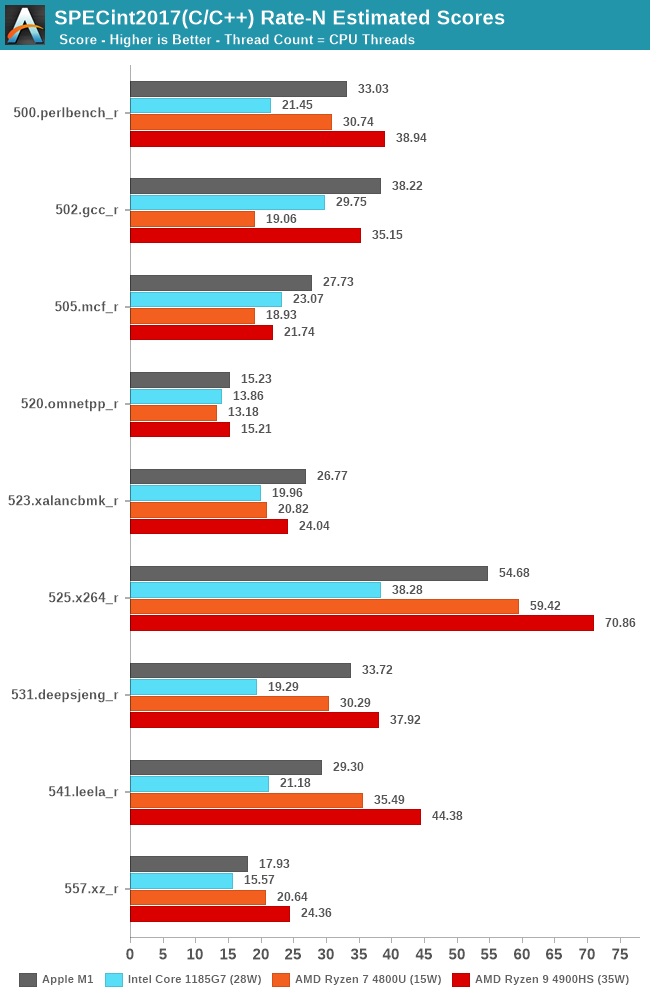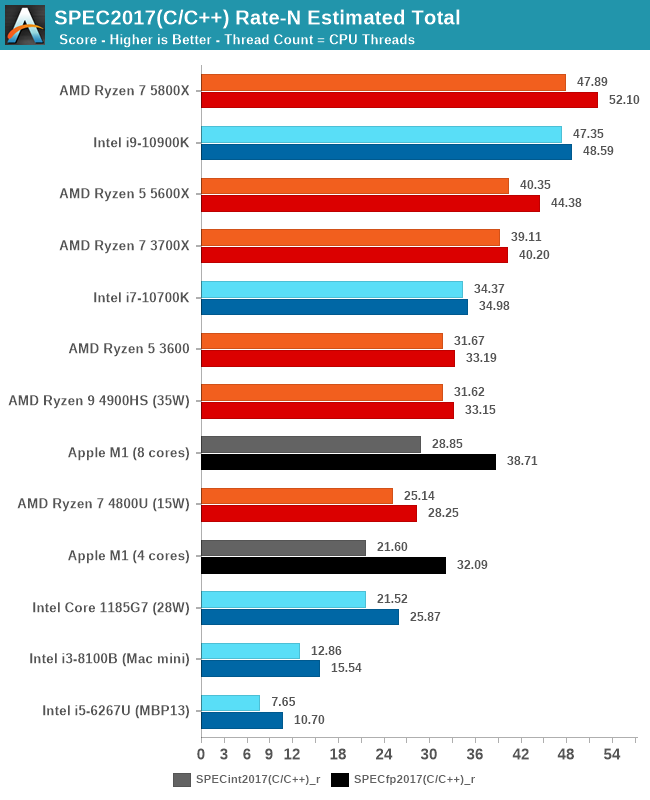The 2020 Mac Mini Unleashed: Putting Apple Silicon M1 To The Test
by Andrei Frumusanu on November 17, 2020 9:00 AM ESTSPEC2017 - Multi-Core Performance
While we knew that the Apple M1 would do extremely well in single-threaded performance, the design’s strengths are also in its power-efficiency which should directly translate to exceptionally good multi-threaded performance in power limited designs. We noted that although Apple doesn’t really publish any TDP figure, we estimate that the M1 here in the Mac mini behaves like a 20-24W TDP chip.
We’re including Intel’s newest Tiger Lake system with an i7-1185G7 at 28W, an AMD Ryzen 7 4800U at 15W, and a Ryzen 9 4900HS at 35W as comparison points. It’s to be noted that the actual power consumption of these devices should exceed that of their advertised TDPs, as it doesn’t account for DRAM or VRMs.

In SPECint2017 rate, the Apple M1 battles with AMD’s chipsets, with the results differing depending on the workload, sometimes winning, sometimes losing.

In the fp2017 rate results, we see similar results, with the Apple M1 battling it out with AMD’s higher-end laptop chip, able to beat the lower TDP part and clearly stay ahead of Intel’s design.

In the overall multi-core scores, the Apple M1 is extremely impressive. On integer workloads, it still seems that AMD’s more recent Renoir-based designs beat the M1 in performance, but only in the integer workloads and at a notably higher TDP and power consumption.
Apple’s lead against Intel’s Tiger Lake SoC at 28W here is indisputable, and shows the reason as to why Apple chose to abandon their long-term silicon partner of 15 years. The M1 not only beats the best Intel has to offer in this market-segment, but does so at less power.
I also included multi-threaded scores of the M1 when ignoring the 4 efficiency cores of the system. Here although it’s an “8-core” design, the heterogeneous nature of the CPUs means that performance is lop-sided towards the big cores. That doesn’t mean that the efficiency cores are absolutely weak: Using them still increases total throughput by 20-33%, depending on the workload, favouring compute-heavy tasks.
Overall, Apple doesn’t just deliver a viable silicon alternative to AMD and Intel, but actually something that’s well outperforms them both in absolute performance as well as power efficiency. Naturally, in higher power-level, higher-core count systems, the M1 can’t keep up to AMD and Intel designs, but that’s something Apple likely will want to address with subsequent designs in that category over the next 2 years.










682 Comments
View All Comments
GeoffreyA - Thursday, December 3, 2020 - link
Sad, but true. I remember his "Road Ahead" article in 2014 and that was it. Gone. Well, let's hope the man leaves Apple someday and comes back home to Anandtech. I know, the chances of that happening are exceedingly slim.pjc15 - Saturday, November 21, 2020 - link
This might be evidence that ARM is the way of the future, but Intel, AMD, and Microsoft are too entrenched in x86 to do anything about it. They would have to maintain x86 and ARM versions of everything, and on the hardware side especially, they don't seem to have the bandwidth to do that. Maybe custom servers will move to ARM, maybe some types of pros will move to macOS if Apple's lead extends, but for the vast majority of cases, x86 is good enough and cheap enough that Wintel will be unaffected. In order to upend the industry, Apple would have to sell its chips to OEMs, or sell sub-$500 computers, both of which have almost no chance of happening.profquatermass - Sunday, November 22, 2020 - link
So where does the M1 go from here?How can they make the M2?
Spunjji - Monday, November 23, 2020 - link
The next move will probably be a larger variant with more (8?) large cores, more (+50%?) GPU resources, a wider (256bit?) memory bus, and LPDDR5. They're all fairly obvious ways to provide higher performance, but they mean a larger die, which means lower yields on a 5nm process that's still in its early stages.utferris - Wednesday, November 25, 2020 - link
I hope there will be Apple ISA. ARM ISA can be limiting at some point if apple want to have their own custom instructions for better performance.And NVidia will be owning ARM, which is the worst thing to Apple and the world.
Focher - Thursday, November 26, 2020 - link
Nvidia owning ARM will have zero impact on Apple.tokale - Friday, November 27, 2020 - link
This is the biggest misconception out there, some folks think Apple's chip fate it tied to ARM. Truth is the only thing ARM related to Apple's chips is the instruction set, everything else's is Apple's.PickUrPoison - Saturday, December 12, 2020 - link
True. But OP is right about instruction set extensions. Do we know there aren’t any? I expected some for perhaps the purpose of Rosetta2 performance acceleration, esp for the on the fly emulation vs. Rosetta2 translation.helpmeoutnow - Thursday, November 26, 2020 - link
looks like another bubble from Apple. but they will sell it as something amazing.PickUrPoison - Saturday, December 12, 2020 - link
Yes, congratulations to Apple, absolutely! As Andrei said, “overall, Apple hit it out of the park with the M1”.